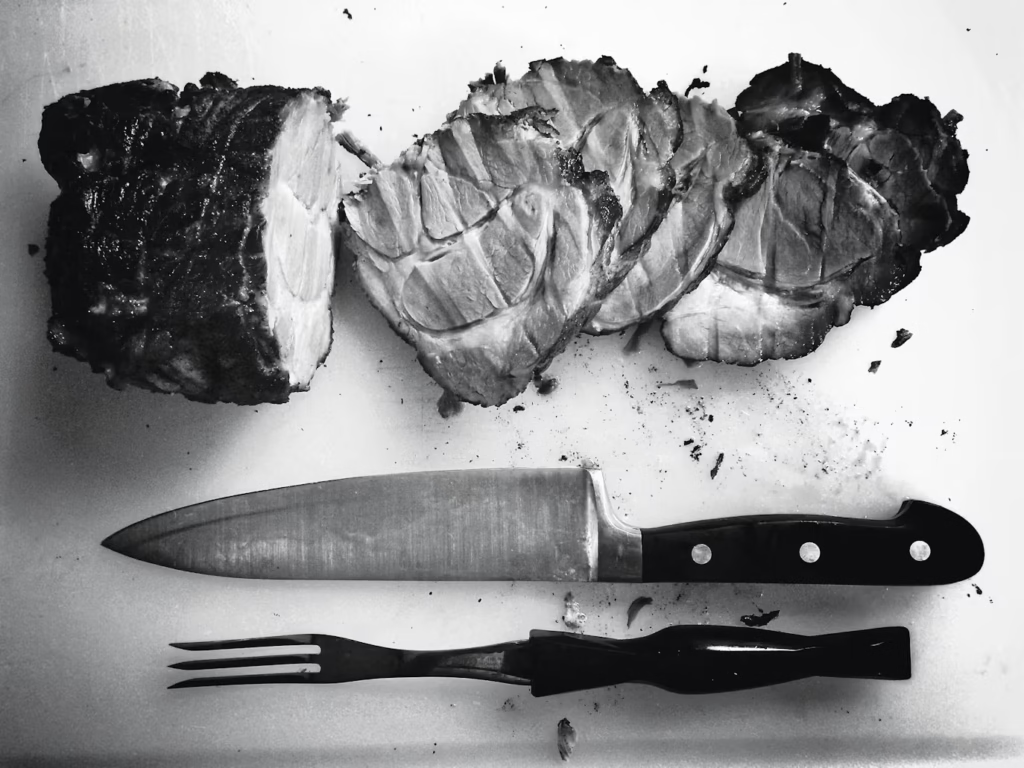Published on August 1, 2025 by Filip
Last updated on August 10, 2025

The truth is, you don’t need a $150 chef knife to cook like you’ve got your act together. In fact, if you have a half-way decent knife under $30, and a cutting board that’s not made of glass (seriously, stop that), then you’re pretty much set.
Knife skills are about control, consistency – not about the price tag.
If you master these five basics, then you’ll be meal prepping like a pro in no time.
1. The Rock Chop (aka The Everyday Hero)
This is your go-to move for almost everything, including onions, herbs, bell peppers, and carrots. The idea is simple: keep the tip of the knife anchored to the board and use a rocking motion when slicing.
This way is safer and faster than regular, intuitive cutting. The key is to let the blade do the work – don’t force it. You’re not hacking through jungle vines.
✅ Best for: Softer veggies, herbs, cooked proteins
🛠 Pro tip: Make sure your cutting board doesn’t slide around. A damp towel underneath can work wonders.
2. The Claw Grip
This isn’t technically a cut, but its essential nonetheless. What you should do is curl your fingers under and hold the food with your knucles forward. This way, your knife should glide against your knucles like a rail.
This one move alone will level up your kitchen game immensely. It will make you look like you know what you’re doing.
✅ Best for: Every kind of slicing
🛠 Pro tip: Practice slowly first. Once it clicks, your speed naturally picks up.
3. The Julienne – A Fancy Word for a Simple Cut
Julienne means “matchstick”, meaning thin, even strips of vegetables, like carrots or zucchini. It’s the art of making tiny, elegant logs from your vegetables.
Cut the vegetable into 2-inch chunks, square off the slides. Then, slice it into planks and stack them. From there, slice again into sticks.
✅ Best for: Stir-fries, salads, and showing off
🛠 Pro tip: Keep that blade sharp. Dull knives crush instead of slice.
4. The Dice (Small, Medium, Large)
Dicing is about control and consistency. For onions, for example, cut off the non-root end, then slice it vertically towards the root, make horizontal cuts, and finally – chop downwards.
Mastering dice helps with even cooking and keeps your dishes from feeling amateur-ish.
✅ Best for: Onions, tomatoes, potatoes, garlic
🛠 Pro tip: Don’t rush. Even small knives under $30 can do this perfectly if you’re precise
5. The Chiffonade (aka The Leaf Stack Slice)
This cut is great for herbs and leafy greans, such as basic and spinach. What you should do is stack the leaves, then roll them like a cigar, and slice across into rhin ribbons.
It’s a delicate and clean cut, which adds that final touch without needing extra kitchen gear.
✅ Best for: Basil, mint, spinach, Swiss chard
🛠 Pro tip: Use a gentle sawing motion — don’t crush the greens.
It’s Not The Knife, But The Hands That Use It
You definitely don’t need a high-carbon Damascus steel in order to lock-in your knife skills. A well-reviewed budget chef knife and a little repetition go a long way. These cuts aren’t complicated, but they can make a huge difference in how confidently you cook. After you hone your skills, then something like a chef knife under $150 can be your next logical step for advancing your efficiency and setup.
Once you got these moves locked in, any future upgrades you make to your gear will actually feel worth it, considering you’ll know how to use them. If you’re interested in more knife truths, have a look at my page where I myth-bust common chef knife misconceptions.
